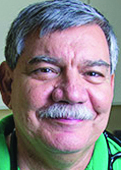Disparities between COVID-19 data reported by Starr County and data reported by the state have existed for months, but confusion over the numbers has only grown in recent weeks given sudden jumps in confirmed cases and the lack of detailed information.
Dr. Antonio Falcon, Starr County’s local health authority, addressed the confusion during a news conference Wednesday morning. He said the daily number of new coronavirus cases publicized by the county versus the number published by the Department of State Health Services would continue to be different but the overall number would be the same.
“The data that has been given to the press has never been 100% correct because of the number of entities that were testing and not reporting,” Falcon said.
“Our numbers are important for trends versus looking at each number,” he added. “I understand the need to have precise data but we’re doing the best that we can with the information that we’re getting.”
The data the county and the state reports, Falcon said, are parallel to each other but are not reported at the same time.
One example, he said, were 345 coronavirus cases in Starr County that were previously unreported by DSHS.
Dr. Emilie Prot, the regional medical director for DSHS Public Health Region 11, said last week that those test results were from tests administered as far back as June.
Of those 345 cases, Falcon said the county determined 191 were already accounted for in their own tabulation.
“That has a lot to do with who is reporting when,” Falcon said, referring to the labs that conduct the tests.” For example, not everybody who is doing testing in the community is reporting the numbers to us, yet they have to report positive numbers to (DSHS).”
Falcon reiterated that the county’s and the state’s numbers are “running in parallel but at different times” and said that if people wanted to find exact final numbers that were official, to refer to the DSHS data.
“Please remember that the numbers for (DSHS) are going to be different because there has to be some reporting that has to be done to them that does not have to be done to us,” he said.
The county previously reported demographic information for each case, listing the age, sex, and the city of which the person was a resident.
But Falcon said they would no longer provide that information to the public, citing the Health Insurance Portability and Accountability Act, or HIPAA, which is meant to prevent the disclosure of patient information without the patient’s consent.
Despite the uncertainty over exact figures, Falcon said the numbers were trending down
“Our numbers are significantly down and that’s great,” he said. “We can reassure people that things are much better.”
He added that over a seven-day period, from Sept. 1 to Sept. 7, the county had 128 positive cases which he touted as an improvement.
The situation at the hospital continued to improve as well, according to Thalia H. Muñoz, CEO and Administrator of Starr County Memorial Hospital.
She reported there were only five patients in the hospital’s COVID unit and none were on ventilators, though they were on high flow oxygen.
In July, when hospital staff were struggling to adequately care for their high number of COVID-19 patients, the U.S. Department of Defense deployed two U.S. Navy Rural Rapid Response Teams to the hospital.
Those two teams were “demobilized” and, on Monday, the hospital held a ceremony to thank them for their services, Muñoz said.
“They were a tremendous, tremendous help,” she said. “They assured us that if the need arose, they would come back in.”
She added that 24 medical employees supplied by the state — doctors, nurses, medical technologists, respiratory therapists — were still assisting at the hospital.
Healthcare officials have, in general, remained cautiously optimistic about the COVID-19 situation throughout the Rio Grande Valley, especially as they wait to see if there is a spike in infections following the Labor Day weekend.
Similarly, Falcon said the county will continue monitoring the situation.
“We have to remain vigilant and so we will be watching very carefully — checking with doctor’s offices, checking with the state health department, checking with as many laboratories that are doing testing right now,” he said. “Checking with them to see what the trends are and if we see that the trends are unfavorable, we certainly will depend on the support of the press to get the word out so that the community can start taking care of itself.”





